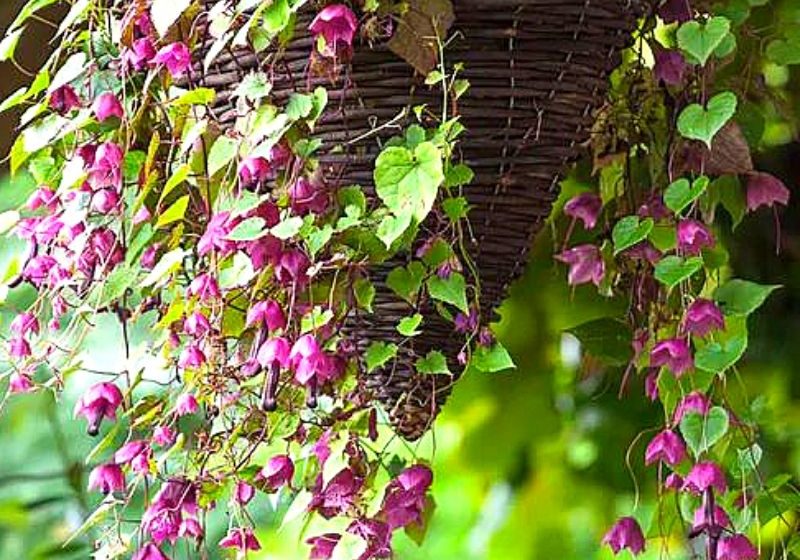
Are you looking for some new options in trailing plants to include in your hanging baskets besides the commonly found petunias, bacopa, and geraniums? Our list of the 23 best trailing plants for hanging baskets (but not limited to) are low-maintenance, drought tolerant varieties, and plants for either sun or shade. We also included a few trailing plants for indoors.
Best Outdoor Flowering Plants For Hanging Baskets
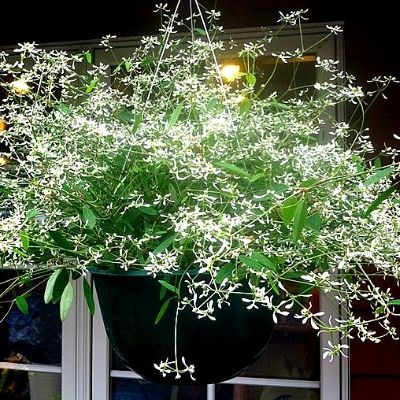
Euphorbia Ice Mist
Euphorbia “Ice Mist” is sometimes sold under the trademarked name euphorbia “Diamond Frost”. It has a nicely rounded growth habit when grown in hanging baskets featuring prolific small white blooms all year long. Ice mist somewhat resembles a larger version of baby’s breath and is mostly grown as an annual. Winter hardy in zones 10-12. Plants will grow 12-20 inches tall with a similar spread. Best in full sun.
Lantana montevidensis is a trailing type of lantana mostly used as a groundcover due to it’s trailing or spreading habit. This also makes it the best lantana for hanging baskets because it will ramble right over the sides with a “weeping” habit. Flower clusters appear from summer through fall. Color choices include everything from white, yellow, orange, red, lavender and purple to bi-colors. Lantana is a perennial and will perform best in full sun. Zones 8-12.
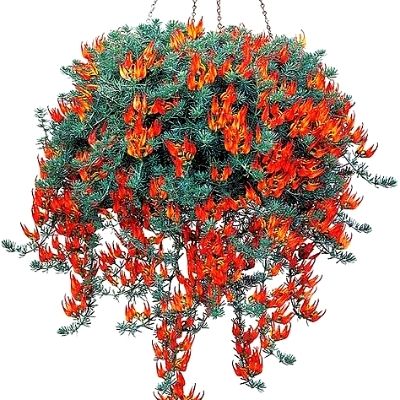
Lotus Vine
A native of the Canary Islands, Lotus Vine plants have silvery fine textured foliage and red flowers somewhat resembling an upside-down parrot’s beak and blooms in the spring. Mostly grown as an annual, the Lotus Vine needs full or part sun. Zones 9-11.
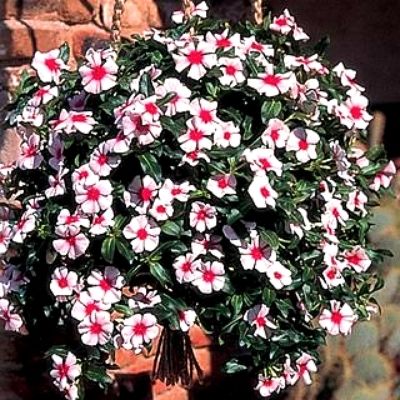
Trailing Madagascar Vinca
Madagascar Vinca (also known as Vinca Major, or annual Vinca) is a great choice for high heat tolerance. It can definitely take the heat and keeps blooming. “First kiss blueberry” is one of my favorites.
Vinca will grow in part sun but will flower best in full sun. It is a drought tolerant plant but performs best when watered frequently. Hardy in zones 7-10.
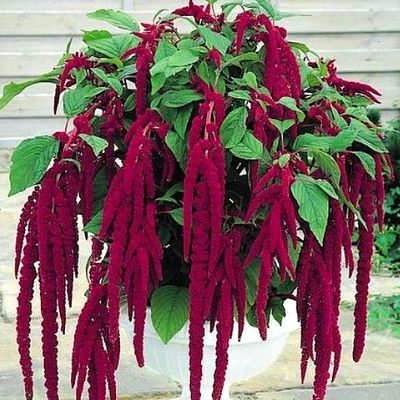
Amaranthus (Love Lies Bleeding)
Amaranthus caudatus, also known as “Love Lies Bleeding”, bears long weeping tassels of burgundy red flowers against emerald green foliage. Grown as an annual in full sun, it will require regular watering. Hardy in zones 5-11.
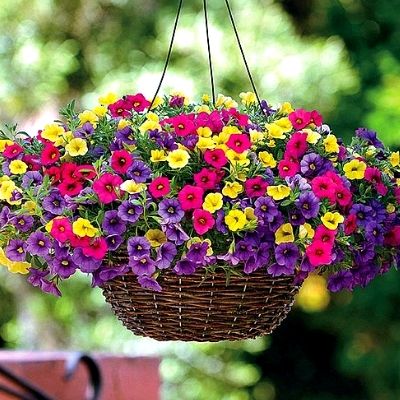
Calibrachoa in a hanging basket, mixed colors
Calibrachoa, commonly known as Million Bells due to its prolific flowering nature. I’ve heard them called “petunias on steroids” and that phrase was well deserved. Flowers resemble small petunias and come in a wide range of colors including some bicolors.
Million Bells has become popular in recent years due to their reliable flower production all summer long. Calibrachoas are tender perennial plants. Treat as an annual north of zone 10.
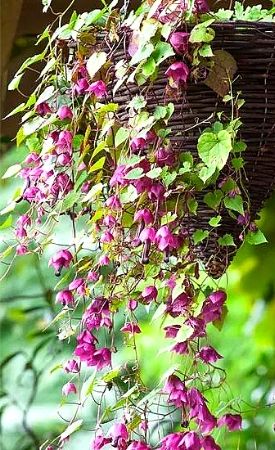
Purple Bells Vine hanging basket plant
Purple Bell Vine “Rhodochiton atrosanguineum” is a climber in its native habitat in Mexico. This plant features gorgeous bicolored pink flowers adorned with hanging dark purple pendants. You could say the flowers resemble fuschias. The Purple Bell Vine is free-flowering, blooming early summer to late fall.
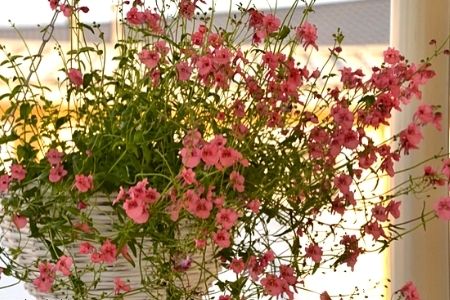
Diascia plant
Diascia is an herbaceous perennial native to South Africa. Flower colors range from white to coral and orange bicolors. Diascia is at home trailing over the edges of hanging baskets with bountiful flowers from spring all the way through fall. Full sun, hardy in zones 8-11.
Drought Tolerant Succulents For Hanging Baskets
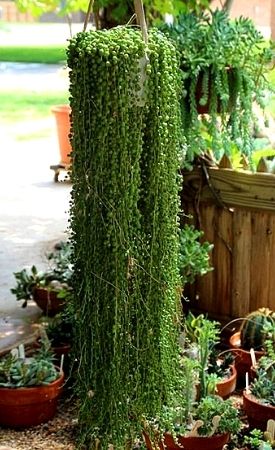
String Of Pearls plant in a hanging basket
String Of Pearls (Senecio rowleyanus) This lovely succulent can grow indoors in a bright area or outdoors with some protection from direct midday sun. String Of Pearls is covered by small, perfectly round green “pearls” on trailing stems that will grow up to 12 feet long in warmer regions. In areas north of zone 9 it may suffer some die back if left outdoors during colder weather.
While the String Of Pearls plant has been around for decades and you may be familiar with it, did you know there is a variegated variety? Most of the “pearls” on a variegated String Of Pearls plant are striped cream and green colors while other pearls are either all green or all cream colored. The new growth tips and pearls can be tinged in pink.
Interestingly, there are many “strings”, or “chains” of something out there in the world of succulents. Most of them are not related but are similar looking to the String Of Pearls… just replace the pearls with other things. Some examples are:
- String of Bananas (succulent foliage looks like tiny green bananas)
- String Of Dolphins (foliage resembles tiny dolphins, with the “fins” and everything.
- String Of Nickels (Dischidia Nummularia) Grown for its foliage of tiny round thin succulent leaves resembling green coins.
- String Of Turtles (actually a Peperomia plant [Peperomia Prostrata]). The small round succulent leaves look like the pattern of a turtle’s shell.
- String of Hearts (More this one later)
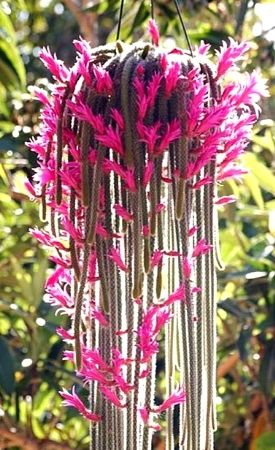
Rat Tail Cactus
Aporocactus flagelliformis, the Rat Tail Cactus is a true cactus with a weeping habit. It’s fuzzy stems can hang up to 5 feet long and bear bright crimson flowers in spring and early summer.
Give the Rat Tail Cactus full sun and a well drained soil.
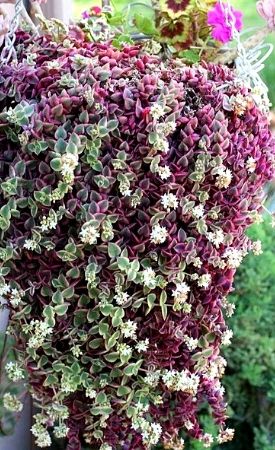
Crassula Calico Kitten
Crassula Marginalis Rubra “Calico Kitty” has variegated green succulent foliage edged in white. The new growth will keep its pink and red color for months. At times, most or all of the plant can be red colored. This trailing variety of Crassula makes a great choice for colorful hanging baskets.
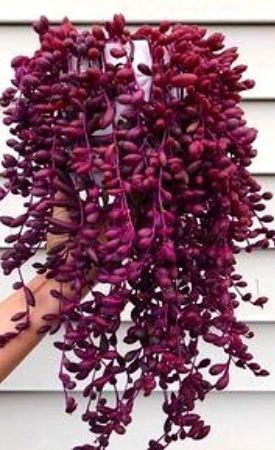
Ruby Necklace succulent
The Ruby Necklace (Othonna Capensis) is a fast growing trailing succulent with red stems and red bean-shaped foliage. Ruby Necklace will thrive in either indirect or direct sun, it will be more green in shade but direct sun will develop the best red coloring. Allow the soil to dry out between waterings. Hardy outdoors during winter in zones 9-11.
More succulents for hanging baskets:
- Medusa’s Head Euphorbia
- Sedum Angelina
- Weeping Jade (Senecio Jacobsenii)
- Burro’s Tail Sedum
Vegetables, Herbs And Fruit Plants For Hanging Baskets
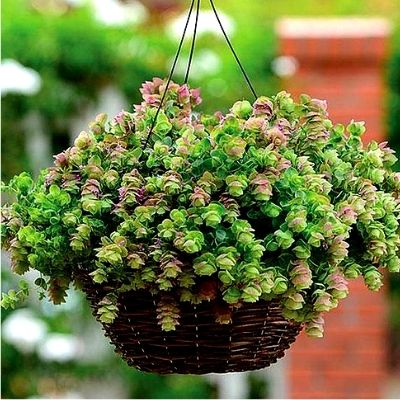
Ornamental Oregano
The foliage of Ornamental Oregano (Origanum rotundifolium) is both colorful and edible. However, you may find the taste is not as good as Greek oregano but it’s still nicely ornamental. Hardiness zones 5-9, it’s fairly easy to grow.
Try the following varieties of ornamental oregano:
- ‘Kent Beauty’
- ‘Kirigami’
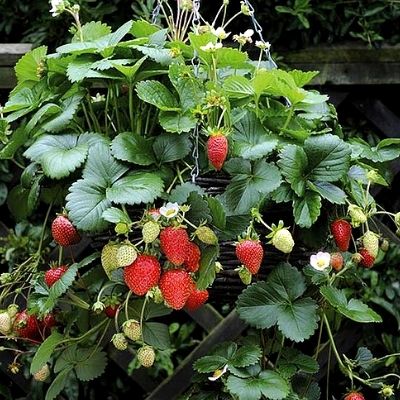
Strawberry Plants
Strawberries are easy to grow and make a delicious summertime treat. Imagine picking fresh plump strawberries right from a hanging basket on your porch, patio, or deck. I have personally grown strawberries in hanging grow bags on my fence for years and they are perfectly happy in hanging container environments.
“Tristan” is an everbearing variety (not pictured) providing large fruits plus the largest flowers of any strawberry varieties at about 1 inch in diameter. It puts on a show all summer with the large flowers and fruit.
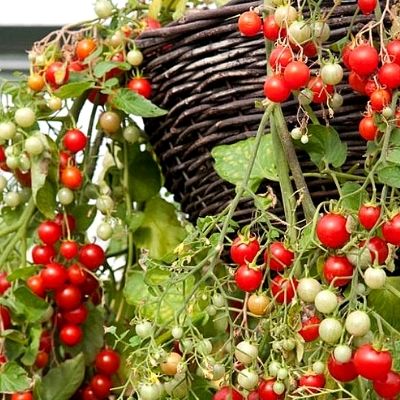
Trailing cherry tomatoes “Tumbling Tom”
Cherry tomatoes are another treat that you can plant in a hanging basket in the summer and get tons of fresh little tomatoes. We recommend “Tumbling Tom” (determinate). Whether you choose Tumbling Tom or another cherry tomato, look for a determinate variety.
A determinate tomato grows long trailing branches that will ramble and hang over the sides of a hanging basket. Indeterminate tomatoes have a bushy habit, growing upwards rather than trailing.
More: You could try “upside down” tomatoes, which is not a type of tomato, but rather a technique in growing them. For more on this, see this link from GardeningKnowHow.com.
Trailing Plants For Shade And Indoors
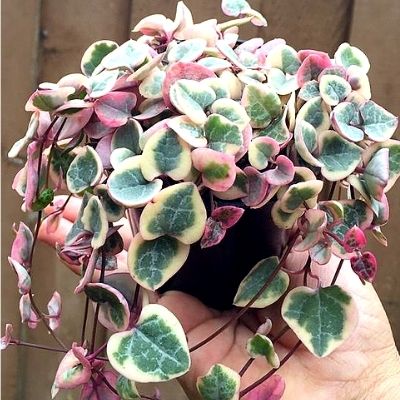
Variegated String Of Hearts succulent
The String Of Hearts Vine (Ceropegia Woodii Variegata) is a drought tolerant succulent that can be kept indoors in a sunny location or outdoors in warm weather. The variegated String of Hearts boasts light green leaves with cream colored edging. This plant can trail several feet in length over time.
Plant your String Of Hearts Vine in average soil mixed with about ¼ sand for good drainage. Allow to dry between waterings to prevent root rot.
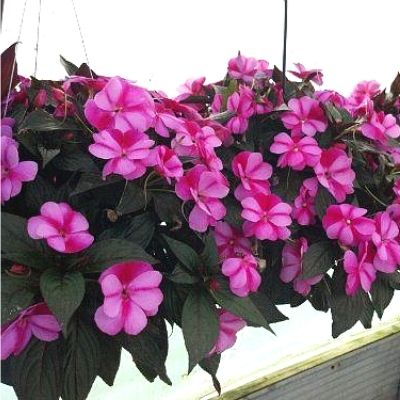
Bi-color New Guinea Impatiens
New Guinea Impatiens hail from the tropics and are kept as annuals north of zone 10. New Guinea Impatiens can handle more sun than the regular impatiens but they still don’t like to be in direct sun for more than 3-4 hours each day. They also have larger leaves and larger blooms, up to 3 inches across.
New Guineas will bloom from spring until fall in purple, red, orange, white, pink, and bicolors (see image above). The foliage can be green or variegated in green and golden yellow. Keep outdoors, winter hardy in zones 10-12.
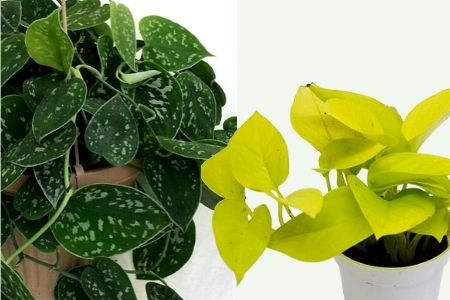
Pothos “Blue Satin” and “Neon”
Pothos (Many Varieties) is one of the easiest houseplants to care for and some varieties of pothos have exotic coloring beyond just the commonly sold “Marble Queen” pothos. Pothos is often confused with Ivy plants.
Pothos prefer low or indirect light and evenly moist soil. It will tolerate drying out somewhat between waterings. They are low maintenance and can handle some neglect.
Recommended (pictured above):
- Blue Satin Devil’s Ivy Pothos featuring dark bluish green leaves with light green spots.
- Pothos “Neon”, bright chartreuse yellow foliage.
Best Foliage Plants
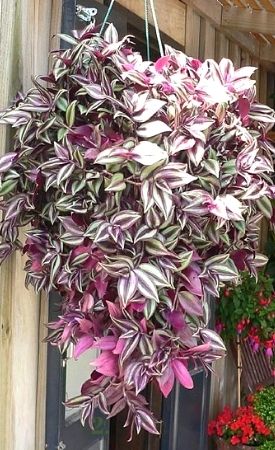
Tradescantia Tricolor “Zebrina”
Spiderwort (Tradescantia) has many common names like the Wandering Jew plant and the Inch Vine or Turtle Vine plant. They are very easy to take care of and will survive some neglect and still provide you with the loveliest foliage all year long. The flowers are small and hardly noticeable against the striking foliage.
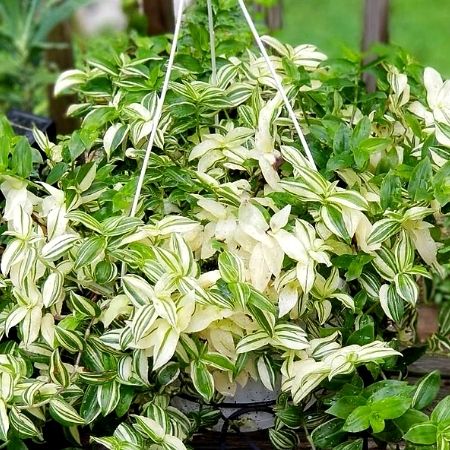
Tradescantia “Albovittata”
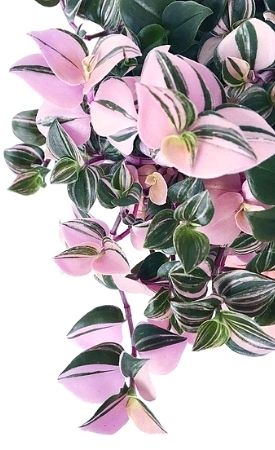
Tradescantia Bolivian Wandering JewTurtle Vine
The following varieties of tradescantia (pictured above, except for ‘microfolia’) are good trailing plants for hanging baskets:
- Tradescantia Albiflora “Albovittata” or Pinstripe Inch Plant
- Tradescantia Quadricolor
- Bolivian Wandering Jew or Turtle Vine (Callisia repens)
- Tradescantia microfolia, Argentine Ivy
Tradescantia loves humidity and regular watering. Part shade to full sun, Zones 8-12.
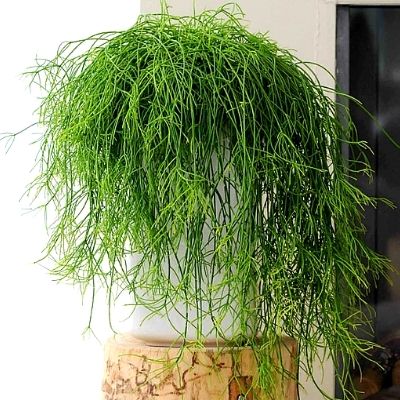
Mistletoe Cactus
Mistletoe Cactus (Rhipsalis baccifera), features lush, finely textured weeping hair-like succulent foliage. Unlike desert cacti, this plant is native to Central and South American rainforests. It is an epiphytic cactus which means it lives on other plants (like rainforest trees in crotches and crevices where leaf matter and debris have collected). Fun fact… The Christmas cactus is another type of epiphytic cactus.
This plant prefers partial to full shade. Mistletoe cactus likes some humidity, it’s a good idea to mist it once or twice a day. The green stems can eventually reach lengths of ten feet in it’s hardiness zone (9-10).
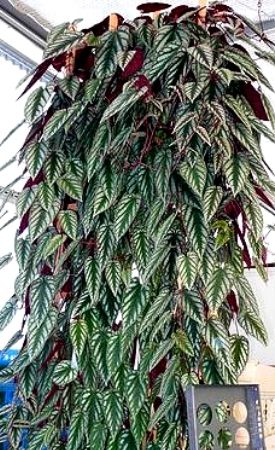
Rex Begonia Vine
The Rex Begonia Vine (Cissus discolor) is a fast growing, exotic looking trailing vine, which is sometimes called the “Tapestry Vine”. Native to the island of Java, Indonesia, This plant gets its name from its leaves which resemble rex begonias, but it’s not a true begonia.
Rex Begonia vines have silver leaves with green veining and purple undersides making it a striking foliage plant. This plant prefers room temperature and partial to full shade. Keep soil evenly moist.
Exotic Choices Perfect For Hanging Baskets
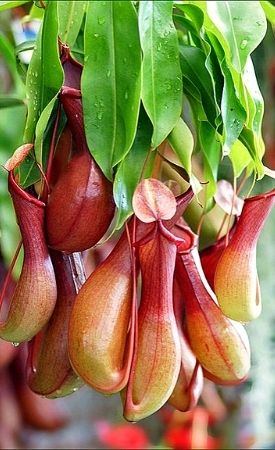
Tropical Pitcher plants (Nepenthes)
Tropical Pitcher plants (Nepenthes) are a carnivorous plant. The name comes from the colorful hanging “pitchers” that collect rainwater and insects inside them. Tropical pitcher plants (Nepenthes) Have hanging pitchers, which are different from Hardy pitcher plants native to North America (Sarracenia) that grow upright from the ground. Be certain when purchasing online that you get the Nepenthes hanging species.
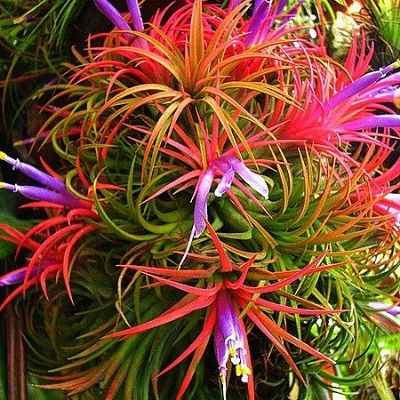
Air Plant
Tillandsia Ionantha, a type of bromeliad, are also known as Air Plants or Sky Plants.
Air plants are another type of epiphyte just like the mistletoe cactus, growing on trees without needing soil.
The foliage of individual air plants look like a miniature pineapple top or sometimes a weeping pineapple top (depending on variety) in colors of grey to green and some feature bright reds and oranges on the tips. The display pictured above is actually many air plants wired into a hanging sphere shape.
Air plants can be watered by placing upright into a bowl of water for a few hours or overnight. Hardy in zones 9-13, outside of these areas you can still keep them outdoors in summer and you can also keep air plants as indoor plants.
General Care And Maintenance For Hanging Baskets
- Use a good lightweight potting soil.
- Use at least a 14-inch basket or larger. Roots tend to dry out too quickly when using small hanging baskets.
- Add play sand or vermiculite to soil for succulents to avoid root rot.
- Make watering while away easy with drip water dispensers for containers. They include a small reservoir of water that slowly drips into the soil while you are away. Also, you can incorporate some water retention crystals into the soil when planting baskets.
See if a plant grows well in your area on the USDA Plant Zone Hardiness Map
Most of these plants can be purchased at local garden centers and nurseries, if that fails, try online retailers. Ebay, Amazon, And Etsy all sell a wide variety of rare and unique plants.
That wraps up our list of 23 outstanding plants for hanging baskets. What’s your favorite? Did one of these plants catch your eye enough to try growing one?
